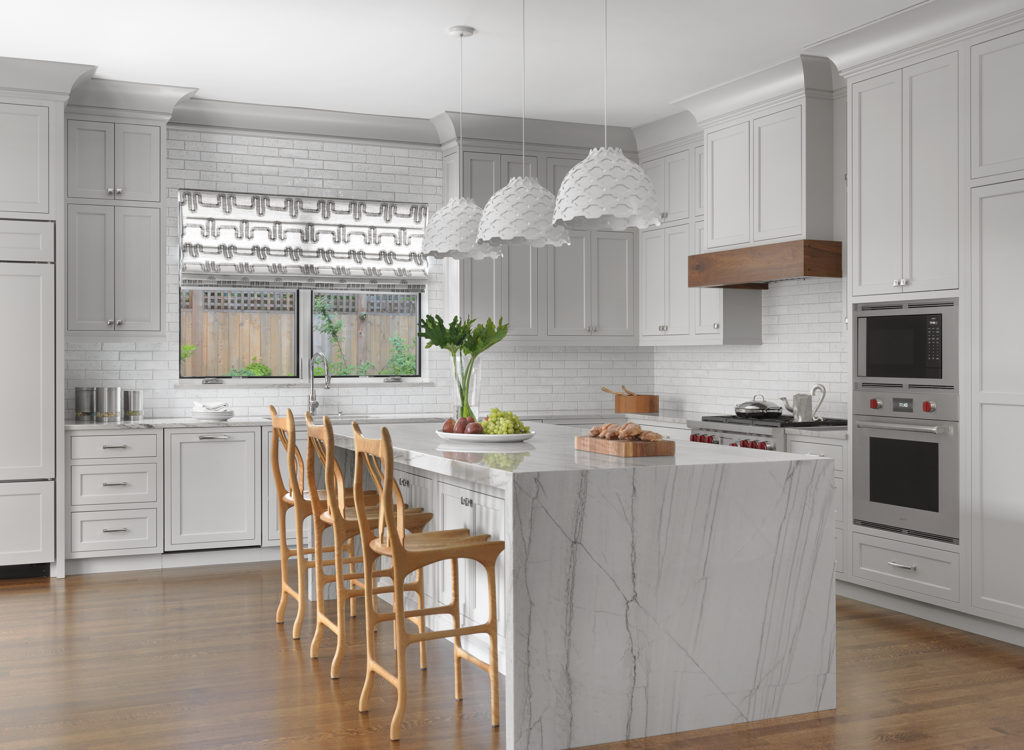Choosing the best material for your countertops doesn’t mean merely picking the most beautiful, the most durable, or even the most affordable. Instead, choose the countertop best suited to your lifestyle. Marble, quartz, and quartzite are three of the most popular countertop materials available; all have their pros and cons, the key is to educate yourself so you can make an informed decision.
MARBLE
Marble is the most beautiful, but the most vulnerable, of these three materials. It is a natural stone, and its stunning veining is almost impossible to replicate in manufactured alternatives. However, its elegant beauty requires a lot of time and attention to maintain. Marble is very porous, meaning spills can stain. So, if you are the type of person who will notice streaks and water spots, then marble in your house may drive you crazy. If you enjoy natural character and lived-in texture, marble may be just right for you. In Europe, homeowners will keep the same slab of marble for decades adding patinas with each spilled glass of wine. In this tradition, each stain adds to the development of a countertop’s organic and unique history—your home’s identifying thumbprint. In North America, buyers covet marble because it offers the most pristine white color available in natural stone.
PROS:
- Undeniably beautiful, with striking natural veining
- Reliably heat resistant
- Potentially rich in character
- Available in the purest white available in natural stone
CONS:
- Porous; it will stain easily
- Fragile; will etch and scratch (avoid using sharp knives directly on its surface)
- Requires considerable upkeep if you want to keep it clean
- Due to its vulnerability to scratches, stains, and breakage some manufacturers won’t warranty marble if used in a kitchen
QUARTZ
In recent years, quartz has become one of the most utilized materials in household countertops. The engineered material, consisting of various synthetic resins and natural quartz minerals, is durable, reasonably heat resistant, and easy to clean. Because it is human made, it is also available in a broader range of colors and patterns. However, quartz countertops lack much of the natural beauty found in marble because of the way they are constructed. You can find patterns that mimic the look of marble, but the printed, repetitive designs make it easy to spot the difference. Quartz’s reliable durability makes it perfect for people who like to keep things pristine, even in areas of great use and traffic. It works well in utilitarian spaces like the laundry room or a secondary bathroom. Do you have places in your house where sturdy reliability trumps aesthetics? If so, quartz may be the perfect material for you.
PROS:
- Very durable
- Stain-resistant and easy to clean
- It won’t dent or chip easily
- You’ve got options! Comes in a large variety of colors and patterns that is always expanding.
CONS:
- Patterns look printed because they are human made
- Not resistant to scratches
- Vulnerable to heat; anything over 300 degrees can melt and discolor the plastics in its resin
QUARTZITE
If you can’t give up the natural beauty of marble, or the durability of quartz, then quartzite might be the answer. Quartzite is a natural stone with beautiful veining similar to marble. Moreover, it’s tougher than granite! It is also heat resistant, and when adequately sealed and treated, it is reasonably resistant to staining. However, it can be scratched, so always use a cutting board when possible.
PROS:
- Beautiful natural stone, with veining similar to marble
- More durable than granite!
- Easy to clean when properly sealed
- Heat resistant
CONS:
- Still vulnerable to scratches
- Can be susceptible to stains if not sealed properly.
Bottom Line?
Choose the material that best suits your household’s needs. If your top priority is aesthetics, then marble is the way to go. Like a variety of patterns and colors and easy clean-up? Then quartz is for you. Pick quartzite if you refuse to compromise beauty or brawn. It’s also good to keep in mind that all three materials are available polished (glossy) or honed (matte), so consider which look best fits your aesthetic. Overall, pay attention to how you use a space; this will reveal the material that is right for you.




